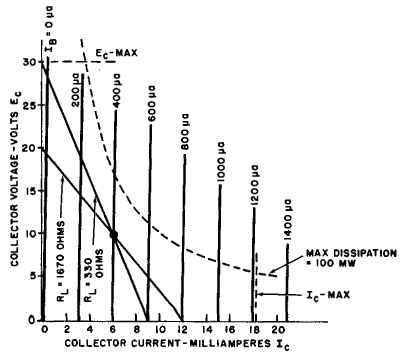| Transistor Basics is a free introductory textbook on transistors and their basic applications. See the editorial for more information.... |

|

Home  Transistor Amplifiers Transistor Amplifiers  The D-C Operating Point The D-C Operating Point  Limitations, Supply Voltage and Load Limitations, Supply Voltage and Load |
||






|
||
|
Limitations, Supply Voltage and LoadAuthor: Leonard Krugman
Fig. 5-1. Selecting the d-c operating point. Suppose, for example, a transistor, whose characteristics are illustrated in Fig. 5-1, is to be used with its operating point set at Ec = 10 volts, Ic - 6 ma. Assume, also, that the maximum limits of the transistor are Ic = 18 ma, Ec = 30 volts, and collector dissipation = 100 milliwatts, as shown enclosed by the dotted lines. The supply voltage required is the value at the intersection of the load line and the collector voltage axis. Thus, for a fixed load of 1,670 ohms, the necessary supply voltage is 20 volts. If, however, the supply voltage is fixed, then the load resistance is determined by the line joining both the supply voltage (Ec at Ic = 0) and the operating point. As an illustration, assume the supply voltage is For any selected operating point there are many combinations of load resistance and supply voltage that will permit the load line to pass through the d-c operating point. The usual problem is one in which both the load and supply voltages are fixed. The problem then resolves itself into a choice of the operating point. In Fig. 5-1, for the conditions RL.= 1,670 ohms, and Ebb = 20 volts, the d-c operating point may be placed anywhere along the load line. It is usually desirable to design the amplifier for maximum signal handling capacity. In this case, then, the d-c operating point should be midway between the extreme limits of the base current, namely 0 and 800 microamperes. The choice of Ib = 400 microamperes sets the operating point for maximum signal capacity at Ic = 6ma, and Ec = 10 volts.
|
||
Home  Transistor Amplifiers Transistor Amplifiers  The D-C Operating Point The D-C Operating Point  Limitations, Supply Voltage and Load Limitations, Supply Voltage and Load |
||
Last Update: 2010-11-17



 to be Ebb fixed at 30 volts. The resulting load resistance
to be Ebb fixed at 30 volts. The resulting load resistance